2/e
P
P T
©2007 by the McGrawHill Companies, Inc. All rights reserved.
3
Creating Effective Messages
©2007 by the McGrawHill Companies, Inc. All rights reserved.
McGrawHill/Irwin
Communication Design
◦
intrapersonal process of planning for and creating meaningful messages
3
Communication design
Communication Design
FIGURE 3.1 Eight Steps of Communication Design
4
Map Out Message Goals
◦ outcome that you want to achieve and the
reason you are communicating
Goal
◦ outcome that you want to achieve
Primary goals
◦ help you to achieve your primary goals
5
Secondary goals
Map Out Message Goals
•
◦
practicality of your message goals
Is the Goal Feasible? Feasibility
Goal intention
◦ what you specifically want, need, or intend to do
• What Is My Intention?
Response
◦
reaction you want or expect from your receiver
6
• What Response Do I Want?
Map Out Message Goals
TABLE 3.1 Goal Intention
7
Evaluate Your Audience
◦
individual or group who receives a message
Audience
• Does the Size of the Audience Matter?
Internal business audience
◦
people employed by the same company
External business audience
◦
customers or clients and those who work in other similar organizations
8
• What Is the Type of Audience?
Evaluate Your Audience
TABLE 3.2
Types of Audiences
9
Evaluate Your Audience
• What Do I Need To Know About My
Audience?
• What’s Known and What’s New
10
• What’s Real and What’s Right
Evaluate Your Audience
• What Is the Audience Benefit?
• What’s First and What’s Last
◦
sensitivity to someone else’s feelings and situation
11
Empathy
Evaluate Your Audience
FIGURE 3.2 Audience Demographics
12
Evaluate Your Audience
© © Brand X Pictures/PunchStock
© Royalty-Free/CORBIS
13
Shape Message Content
◦
goal you want to accomplish with your message
Main Idea
◦
specific point of view about an idea or topic
14
Theme
Shape Message Content
Argument
◦
appeal to influence behavior or belief through reasoning
• Designing Arguments
Framing
◦
tailoring a message to your specific audience
• Framing Your Content
15
• Message Elements
Select Channels
◊ Channel carries messages between people
◊ Sight, sound, smell, taste, and touch
• Keys to Channel Selection
16
• Channel Choices
Select Channels
FIGURE 3.3 Primary Human Channels
17
Select Channels
TABLE 3.3
Channel Keys
18
Select Channels
TABLE 3.4
Channels (1 of 2)
19
Select Channels
TABLE 3.4
Channels (2 of 2)
20
Acquire Resources
◦ process of acquiring information to ensure
message accuracy, support a claim, or guide decision making
21
Research
Acquire Resources
TABLE 3.5
Resources
22
Generate Source Credibility
◦
live person, narrative voice, business entity, or author from whom the message is transmitted
Source
◦ making your message believable
Credibility
◦ expertise or knowledge that a source has in a
given area
23
Competence
Generate Source Credibility
◦
trustworthiness of a message source
Reliability
◦ demonstrated enthusiasm the source has
about the message
Dynamism
◦ connection the source has with his or her
audience
24
Similarity
Generate Source Credibility
FIGURE 3.4 Source Credibility
25
Eliminate Design Flaws
Table 3.6
Design Flaws (1 of 4)
26
Eliminate Design Flaws
Table 3.6
Design Flaws (2 of 4)
27
Eliminate Design Flaws
Table 3.6
Design Flaws (3 of 4)
28
Eliminate Design Flaws
Table 3.6
Design Flaws (4 of 4)
29
Send Message
Timing
◦ when you transmit your message
Time-related messages or materials
◦
have a limited life span
• When to Transmit
Location
◦
place from which you transmit your message
30
• Where to Transmit
Questions
31





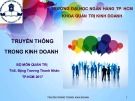
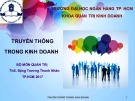
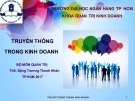
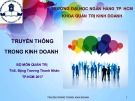

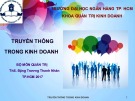


![Đề thi kết thúc học phần môn Truyền thông trong kinh doanh [năm học mới nhất]](https://cdn.tailieu.vn/images/document/thumbnail/2025/20251015/dilysstran/135x160/93281760499390.jpg)


![Bài tập nhóm truyền thông marketing tích hợp [mới nhất]](https://cdn.tailieu.vn/images/document/thumbnail/2025/20250904/hakanami1502@gmail.com/135x160/90671756969236.jpg)





![Định vị doanh nghiệp: Bài thuyết trình [Mới nhất]](https://cdn.tailieu.vn/images/document/thumbnail/2025/20250813/vuthuhuyen1407/135x160/6261755072381.jpg)



